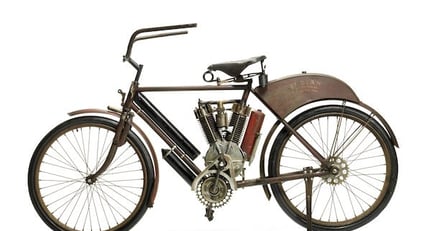Indian 5 HP
-
Motorcycle typeStreet
-
Engine numberT 2029
-
Lot number345
-
ConditionUsed
-
ColourOther
-
Location

Description
c.1908 Indian 5hp 'Camelback' Twin Project
Engine no. T 2029
Rare early Indian twin
Incomplete condition
Offered for restoration
As Indian approached its tenth birthday, the design of Oscar Hedstrom's original single-cylinder motorcycle had begun to mature. Like the vast majority of its contemporaries, the early Indian owed much to traditional bicycle design, which was hardly surprising as Hedstrom and his partner Oliver Hendee had started out in the cycle business. Other manufacturers, most notably arch rivals Harley-Davidson, had started with a clean sheet of paper, adopting what was generally known as the 'loop' frame that wrapped around the engine. Indian did not go down this road until 1909, abandoning the old 'diamond' frame. Chain drive, an advanced feature in motorcycling's early pioneering days, had been used by Indian right from the start but the company felt compelled to offer belt-driven models as well to satisfy dealer demand. They were soon dropped.
The Indian single proved immensely successful and provided the basis for the first of the powerful, large-capacity v-twins for which the marque is best remembered. Indian's first, 38.61ci (633cc) v-twin appeared in 1907 with an engine clearly derived from that of the single, though mechanical inlet valves were an early improvement (the 'atmospheric' type remained an option). The twin's rear cylinder continued to form part of the frame until 1909 when the Harley-style loop frame was adopted. The Springfield company's first production (as opposed to racing) 'Big Twin' debuted that same year, displacing 60.32ci (988cc). Prior to the appearance of a torpedo shaped fuel tank in 1909, a hump-shaped tank mounted behind the seat had been an Indian trademark, leading to the adoption of the 'Camel Back' sobriquet for these early models. The arrival of the larger and more powerful Big Twin meant that the smaller version's days were numbered and the model was last catalogued for the 1911 season.
It is not known when its late owner purchased this rare, early, Indian twin, though it is likely to have been some years prior to his passing in 1995. The painted parts: frame, forks, tank and mudguards appear to be in original condition, while the chain case is reproduction. The saddle's leatherwork has been repaired, and historic repairs to the inlet manifold and oil tank are visible. Missing parts include the ignition system and handlebar controls. Prospective purchasers should satisfy themselves with regard to the age, condition and completeness of the Lot and its components prior to bidding. Sold strictly as viewed.




